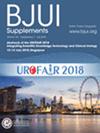EndoSheath use in flexible cystoscopy: a prospective evaluation of >1000 cases
IF 3.7
2区 医学
Q1 UROLOGY & NEPHROLOGY
引用次数: 0
Abstract
ObjectivesTo investigate patient tolerability and safety (using urinary tract infection (UTI) as a proxy measure) following EndoSheath‐assisted flexible cystoscopy (eFC). EndoSheaths are single‐use, disposable sheaths used in FC. They reduce cystoscope turnaround times as complicated, time‐consuming and costly sterilisation is no longer necessary. This reduces patient waiting times as cystoscope idle time, the most common rate limiting step, is reduced.Patients and MethodsAll adult patients undergoing eFC over a 26‐month period at a single institution were evaluated prospectively. Post‐eFC, participants rated discomfort on a visual analogue scale (discomfort 1 = none, 2–4 = mild, 5–7 = moderate, 8–10 = severe). The diagnosis of UTI was broad and based on any one of patient self‐report, positive urine culture or antibiotic prescription within 30 days of eFC. Data were analysed using chi‐squared testing (在柔性膀胱镜检查中使用内鞘:对超过 1000 个病例的前瞻性评估
目的研究患者接受内鞘辅助柔性膀胱镜检查(eFC)后的耐受性和安全性(以尿路感染(UTI)作为替代指标)。EndoSheaths 是用于膀胱镜检查的一次性鞘管。由于不再需要复杂、耗时和昂贵的消毒,它们缩短了膀胱镜的周转时间。患者和方法对一家医疗机构在 26 个月内接受 eFC 的所有成年患者进行了前瞻性评估。eFC 术后,参与者用视觉模拟量表对不适感进行评分(不适感 1 = 无,2-4 = 轻度,5-7 = 中度,8-10 = 重度)。UTI的诊断范围很广,基于患者自我报告、尿培养阳性或eFC后30天内的抗生素处方中的任意一种。结果 在分析的 1091 例 eFC 中,分别有 33.2% 和 48.2% 的 eFC 被评为无不适感或轻度不适感,仅有 3.1% 的 eFC 被评为重度不适感。年轻参与者的不适感较强,但男女之间的不适感相似。总体而言,eFC 后尿毒症发生率为 13.3%,女性(18.1%)高于男性(11.2%)。年龄≥65 岁的参与者尿毒症发病率(15.4%)高于年龄为 65 岁的参与者(8.8%)。结论这项大规模、前瞻性、非选择性的真实世界研究表明,eFC 的耐受性良好。女性尿毒症患者多于男性,年龄≥65 岁的患者也较多,这与其他采用相同的尿毒症广泛诊断标准的研究结果一致。结论是 eFC 具有良好的耐受性和安全性。
本文章由计算机程序翻译,如有差异,请以英文原文为准。
求助全文
约1分钟内获得全文
求助全文
来源期刊

BJU International
医学-泌尿学与肾脏学
CiteScore
9.10
自引率
4.40%
发文量
262
审稿时长
1 months
期刊介绍:
BJUI is one of the most highly respected medical journals in the world, with a truly international range of published papers and appeal. Every issue gives invaluable practical information in the form of original articles, reviews, comments, surgical education articles, and translational science articles in the field of urology. BJUI employs topical sections, and is in full colour, making it easier to browse or search for something specific.
 求助内容:
求助内容: 应助结果提醒方式:
应助结果提醒方式:


